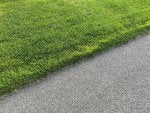Hi everyone,
Last year, I posted about an issue I noticed during my first fall season with Kentucky Bluegrass. In the middle of my fall nitrogen blitz, I observed some lime green or yellow grass blades. To thicken up the KBG, I was applying 0.5 lbs of nitrogen per 1,000 square feet each week using Urea 46-0-0. At the time, I assumed the grass was just growing too quickly.
However, over the summer, I've noticed the same issue spreading to more areas of my lawn, particularly near the street and driveway edges. It doesn’t seem to be Poa trivialis—it looks like my grass, but it’s growing at a much faster rate.
Here’s what I’ve done so far:
Before seeding last year, I conducted a soil test, and here are the results:
![Image]()
Could this be a sign of too much nitrogen? If so, I’m open to reducing the amount, but I figured small doses during the summer, while the grass is healthy and actively growing, wouldn’t be harmful. I don't recall seeing this in the early Spring/Summer so the nitrogen/growing too fast issue doesn't seem out of the question to me. The last application was almost a month ago, would I still be seeing the negative effects from too high of a dose that far back?
Also I noticed I'm on the good/high side for pH, can this influence it? I was considering picking up https://www.lowes.com/pd/Sta-Green-...-Season-40-lb-10500-sq-ft-20-0-0-All-purpose-Lawn-Starter-Fertilizer/5013506421 this fall because of the sulfur.
Any insights on what might be causing this issue would be appreciated.
Spot 1:
![]()
![]()
Spot 2:
![]()
![]()
Spot 3:
![]()
![]()
Last year, I posted about an issue I noticed during my first fall season with Kentucky Bluegrass. In the middle of my fall nitrogen blitz, I observed some lime green or yellow grass blades. To thicken up the KBG, I was applying 0.5 lbs of nitrogen per 1,000 square feet each week using Urea 46-0-0. At the time, I assumed the grass was just growing too quickly.
However, over the summer, I've noticed the same issue spreading to more areas of my lawn, particularly near the street and driveway edges. It doesn’t seem to be Poa trivialis—it looks like my grass, but it’s growing at a much faster rate.
Here’s what I’ve done so far:
- On May 1st, I applied 0.93 lbs of nitrogen per 1,000 square feet with Lesco 25-0-6 slow release.
- On June 13th, I applied an additional 0.25 lbs of nitrogen with 46-0-0 Urea.
- On June 30th, I applied ~0.25-0.35lbs of nitrogen with a mix of 46-0-0 Urea and Lesco 25-0-6 slow release.
Before seeding last year, I conducted a soil test, and here are the results:
Could this be a sign of too much nitrogen? If so, I’m open to reducing the amount, but I figured small doses during the summer, while the grass is healthy and actively growing, wouldn’t be harmful. I don't recall seeing this in the early Spring/Summer so the nitrogen/growing too fast issue doesn't seem out of the question to me. The last application was almost a month ago, would I still be seeing the negative effects from too high of a dose that far back?
Also I noticed I'm on the good/high side for pH, can this influence it? I was considering picking up https://www.lowes.com/pd/Sta-Green-...-Season-40-lb-10500-sq-ft-20-0-0-All-purpose-Lawn-Starter-Fertilizer/5013506421 this fall because of the sulfur.
Any insights on what might be causing this issue would be appreciated.
Spot 1:


Spot 2:


Spot 3:








